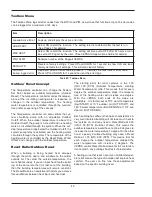
Termination
The vent terminal should be vertical and should termi-
nate outside the building at least 2 ft above the highest
point of the roof that is within 8 ft. The vent cap should
have a minimum clearance of 4 ft horizontally from and
in no case above or below (unless a 4 ft hori-zontal
distance is maintained) electric meters, gas meters,
regulators and relief equipment.
The distance of the vent terminal from adjacent public
walkways, adjacent buildings, open windows and
building openings must be consistent with the NFGC
(U.S.) or B149 (Canada). Vents supported only by
flashing and extending above the roof more than 5 ft
should be securely guyed or braced to withstand snow
and wind loads.
Common Venting
NOTE:
A vent adapter (field-supplied) may be re-
quired to connect the Category IV vent to the boiler.
WARNING:
Vent connectors serving any other
appliances shall not be connected into any portion of
mechanical draft systems operating under a positive
pressure. If an XFyre boiler is installed to replace an
existing boiler, the vent system MUST be verified to
be of the correct size and of Category IV AL29-4C
vent material, approved PVC/CPVC construction, or
Centrotherm™ polypropylene (in Canada, ULC-
S636 approved plastic materials must be used). If it
is NOT, it MUST be replaced.
NOTE:
For extractor sizing, typical CO
2
levels are
8.5% for natural gas and 9.5% for propane gas and
flue temperatures of less than 220°F.
NOTE: Data for 100% firing rate.
Table O: Volume of Flue Products Data
CAUTION:
A listed vent cap terminal suitable for
connection to the Cat IV vent materials, adequately
sized, must be used to evacuate the flue products
from the boilers.
Model No.
Vent Size
(inches)
Volume of Flue
Products (CFM)
300A
4
90
400A
120
500A
150
700A
6
210
850A
250
At the time of removal of an existing boiler, the follow-
ing steps shall be followed with each appliance
remaining connected to the common venting system
placed in operation, while the other appliances remain-
ing connected to the common venting system are not
in operation:
(a) Seal any unused openings in the common venting
system.
(b) Visually inspect the venting system for proper size
and horizontal pitch and make sure there is no
blockage or restriction, leakage, corrosion and
other deficiencies which could cause an unsafe
condition.
(c) Place in operation the appliance being inspected.
Follow the lighting instructions. Adjust thermostat
so appliance will operate continuously.
NOTE:
When using PVC “T” vent as termination,
insert the round stainless mesh screens provided
with the unit into the tee ends.
The minimum flue pipe diameter for conventional vent-
ing is: 4 in. (102mm) for Models 300A, 400A and 500A,
and 6 in. (152mm) for Models 700A and 850A.
The connection from the appliance vent to the stack
must be as direct as possible and shall be the same di-
ameter as the vent outlet. The horizontal breaching of
a vent must have an upward slope of not less than 1/4
inch per linear foot from the heater to the vent termi-
nal. The horizontal portions of the vent shall also be
supported for the design and weight of the material
employed to maintain clearances and to prevent physi-
cal damage or separation of joints.
NOTE:
When
using
Centrotherm
™
Polypropylene “T” vent termination
, insert two
Centrotherm™ termination screens into the tee
ends.
29
WARNING:
An extractor is required when multiple
heaters are vented through a common vent pipe.
The extractor must operate when one or more units
are firing.
The NFGC does not address sizing guidelines for the
common venting of multiple Category IV heaters. This
is covered in the NFGC under “Engineered Vent Sys-
tems”. Table O provides volumes of flue products at
full fire for the calculation of appropriate vent and
extractor sizing for common venting.
Summary of Contents for 300A
Page 44: ...WIRING DIAGRAM 44...
















































